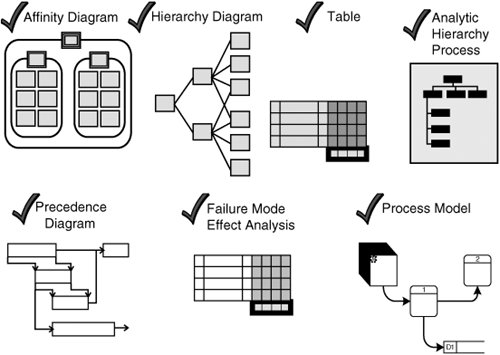Modern QFD for Software
| In response to feedback from both software and nonsoftware organizations using QFD in the early 1990s, a group of experienced practitioners at the QFD Institute[35] (QFDI) applied QFD to QFD to develop a better QFD product.[36] What resulted was Blitz QFD: a faster, better way to do QFD, especially for those just starting to use the method. This is an engineered initial subset of QFD designed to provide maximum gains from a minimum of effort. In practice, Blitz QFD turned out to be the perfect way to get the benefits of QFD on very rapid development projects, and any time that time or resources were tightly limited. The aim is to deliver essential value to key customers rapidly and efficiently. Blitz QFDIn order to do the least QFD and get the most gains, we must focus on QFD fundamentals and apply them to software development.
So what does Blitz QFD have that allows us to answer these questions quickly during software development? The Seven Management and Planning (7 MP) ToolsThe "official" tools for QFD are the Seven Management and Planning (7 MP) Tools (see Chapter 7)[37] as shown in Figure 11.9. While you are not limited to these tools, it is necessary to be familiar with them to take full advantage of Modern QFD.[38] Figure 11.9. The 7 MP Tools for Blitz QFD. The basic tools for traditional QFD are modified for Blitz QFD. Gathered from a variety of disciplines, these tools support rapid requirements exploration and deployment. Note that matrices, which are for detailed analysis, are not used. Customer Satisfaction and ValueCustomers are satisfied when they receive value: benefits greater than the effort or cost to them of achieving those benefits.[39] Customers determine the amount of benefits and costs, and therefore, the value they received. What Is Value?In QFD, value is recognized when customers perceive benefit, either by a problem of theirs that has been solved or minimized; an opportunity they want to seize, maximize, or enable; themselves looking good to significant others; or themselves feeling good about themselves.[40] If a software package does nothing for any of your problems, does not enable you to seize any of your opportunities, does not help you to impress others whose opinion you care about, or does not help you feel better, it is of no value to you. Even a single customer will desire multiple benefits (problems, opportunities, and look good and feel good issues) with different magnitudes and priorities. These are customer needs in QFD terms. A group of customers with similar perceptions of value (benefits and costs) and similar judgments about their magnitudes and priorities is a customer segment. How Is Value Delivered to Customers?Out of the large number of software work objects (objects, data, functions, scripts, and so on) produced during development, only a few directly or strongly relate to any high-priority customer need.[41] This does not suggest that unnecessary items are worked on during development. All the items are there for a reason. And if none of them was delivered, the customer would certainly not be satisfied. But many "necessary" items have no significant effect individually on the amount of value a customer receives. Whether they are done superbly wellor are absent entirelyindividually they do not comprise the difference between customer satisfaction and customer dissatisfaction. In examining ten recently developed Information Technology (IT) development projects in a large retail organization, such "necessary" but nonessential (non-high-value-added) items averaged 73 percent of the items delivered.[42] Doing a great job on items that don't matter to customers is inefficient. What Is Essential to Our Success?A small number of items individually have a very significant effect on the amount of value a customer receives. Done well, they can deliver sufficient value to ensure customer satisfaction. Such high-value items are essential to satisfying the customer. In a large retailer study, the number of essential items in the ten systems studied ranged from 3 to 17.[43] If we could identify these essential items upfront, we could concentrate our best software engineering attention on them. Doing a great job on items of high value to the customer is very efficient development. Further, out of the many development tasks we perform on a software project, only a few are truly critical to performing the essential tasks well. If we could identify these essential tasks upfront, we could concentrate our best project management attention on them. On the few essential tasks, managing for speed is counterproductive; the risk to value is too high. On the many nonessential tasks, managing for speed is very productive. Being able to quickly see which development items are high value and in which project tasks they are performed gives us a framework to efficiently ensure the satisfaction of our targeted customer segment(s). |
EAN: 2147483647
Pages: 394